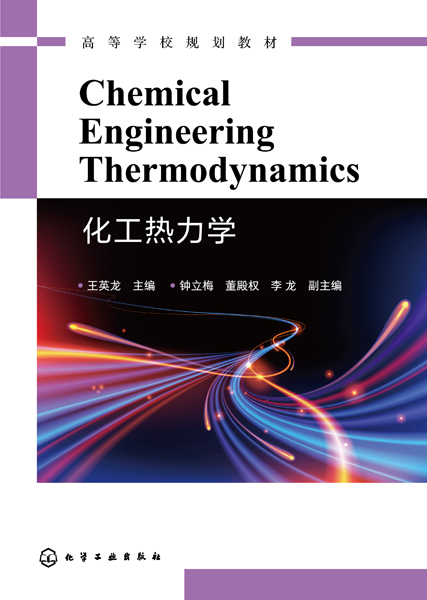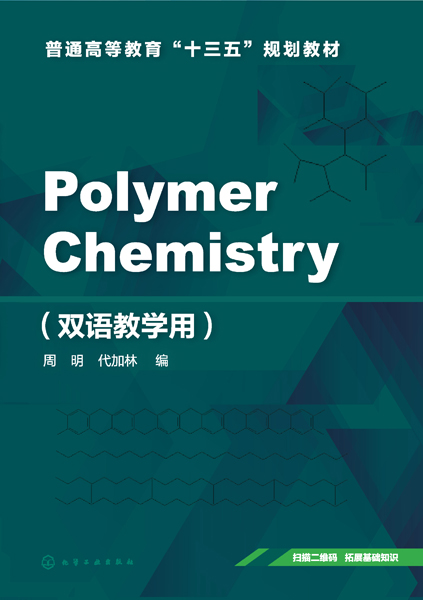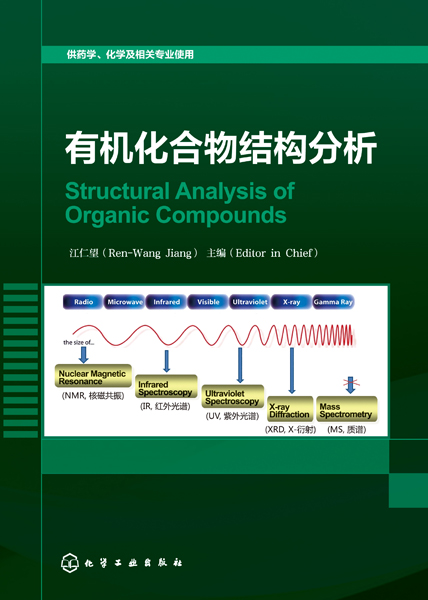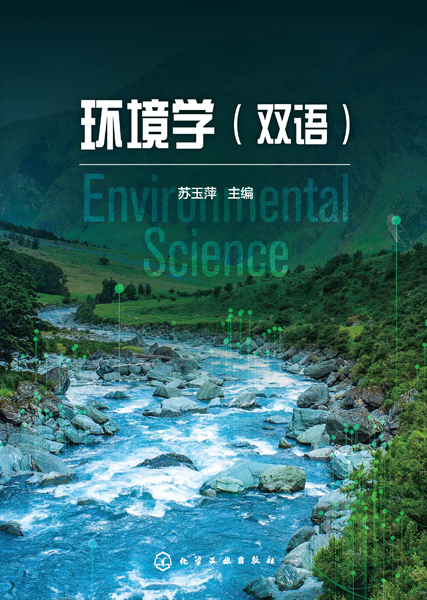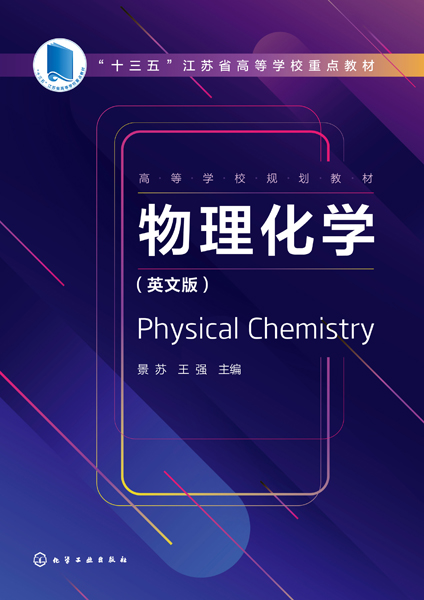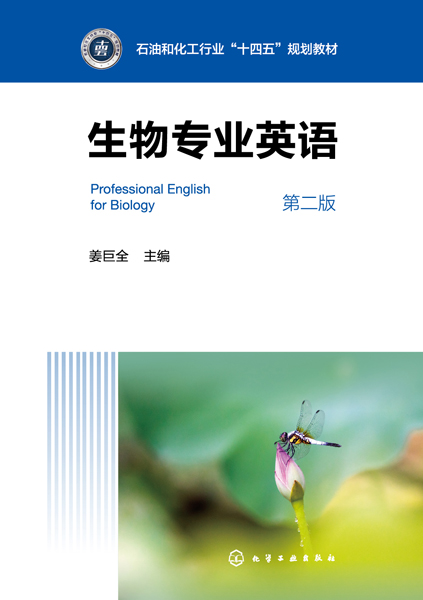Chemical Engineering Thermodynamics(化工热力学)
定价:¥69.00
作者: 王英龙 主编 钟立梅、董殿权、李龙 副主编
出版时间:2022-09
出版社:化学工业出版社
- 化学工业出版社
- 9787122414717
- 01
- 434419
- 16开
- 2022-09
- 496
- 303
- ①TQ013.1
- 本科
作者简介
目录
Chapter 1 Introduction 1
1.1 The Category of Chemical Engineering Thermodynamics 1
1.2 The Role of Thermodynamics in Chemical Engineering 2
1.3 Fundamental Law of Thermodynamics 3
1.4 Application of Chemical Engineering Thermodynamics 5
1.5 The State and System 7
Chapter 2 The Physical Properties of Pure Substances 10
2.1 Pure Substance 10
2.2 Phases of Pure Substance 10
2.3 Phase-change Processes of Pure Substances 11
2.4 Property Diagrams for Phase-Change Processes 13
2.4.1 The T-V Diagram 14
2.4.2 The p-V Diagram 15
2.4.3 The p-T Diagram 17
2.4.4 The p-V-T Surface 17
2.5 Equation of State 22
2.5.1 The Ideal-Gas Equation of State 22
2.5.2 Nonideality of Gases 23
2.6 Other Equations of State 23
2.6.1 The van der Waals Equation of State 24
2.6.2 Redlich-Kwong (RK) Equation of State 25
2.6.3 The Soave-Redlich-Kwong (SRK) Equation of State 25
2.6.4 Peng-Robinson (PR) Equation of State 26
2.6.5 Virial Equation of State 26
2.6.6 Multiparameter Equation of State 27
2.7 Principle of Corresponding States and Generalized Association 33
2.7.1 Principle of Corresponding States 34
2.7.2 Principle of Corresponding States with Two Parameters 34
2.7.3 Principle of Corresponding States with Three Parameters 35
2.7.4 Generalized Compressibility Factor Graph Method 35
2.7.5 Generalized Virial Coefficient Method 36
2.8 Application of Aspen Plus in Calculation of Thermodynamic Equation of State 39
EXERCISES 43
REFERENCES 44
Chapter 3 Thermodynamic Properties of Pure Fluids 45
3.1 Mathematical Relationship between Functions 45
3.1.1 Partial Differentials 45
3.1.2 Partial Differential Relations 47
3.1.3 Fundamental Thermodynamic Relation 48
3.2 The Maxwell Relations 49
3.3 The Clapeyron Equation 51
3.4 General Relations for dU, dH, dA, and dG 52
3.5 Joule-Thomson Coefficient 58
3.6 The ?H, ?U, and ?S of Real Gas 60
3.7 Application of Aspen in Thermodynamic Properties 62
CONCLUSION 64
EXERCISES 66
REFERENCES 68
Chapter 4 The Thermodynamics of Multicomponent Mixtures 69
4.1 Excess Property 70
4.2 Properties Change on Mixing 71
4.3 Partial Molar Gibbs Free Energy 78
4.4 Gibbs-Duhem Equation 79
4.5 The Experimental Measurement of Partial Molar Volume and Enthalpy 82
4.6 Gibbs Free Energy and Fugacity of a Component in a Mixture 89
4.6.1 Ideal Gas Mixture 89
4.6.2 Ideal Mixture and Excess Mixture Properties 91
4.6.3 Partial Molar Gibbs Free Energy and Fugacity 95
4.7 Application of Aspen Plus to Thermodynamic Properties of multicomponent Mixtures 100
CONCLUSION 103
EXERCISES 103
REFERENCES 105
Chapter 5 Phase Equilibrium 106
5.1 Phase Equilibrium for a Single-Component System 106
5.1.1 Mathematical Models of Phase Equilibrium 106
5.1.2 Fugacity and Its Use in Modeling Phase Equilibrium 117
5.2 Vapor-Liquid Equilibrium 121
5.2.1 Motivational Example 121
5.2.2 Raoult’s Law and the Presentation of Data 123
5.2.3 Mixture Critical Points 131
5.2.4 Lever Rule and the Flash Problem 132
5.3 Theory and Model of Vapor Liquid Equilibrium of Mixtures: Modified Raoult’s law Method 134
5.3.1 Examples of Incentives 134
5.3.2 Phase Equilibrium of Mixture 135
5.3.3 Fugacity of Mixture 138
5.3.4 Gamma-Phi Modeling 142
5.3.5 Raoult’s law Revisited 143
5.3.6 Henry’s law 144
5.4 Wilson and Van Laar Equation 155
5.4.1 Wilson Equation 155
5.4.2 Relationship between Activity Coefficient and Temperature and Pressure 157
5.4.3 Van Laar Equation and Regular Solution Theory 160
5.4.4 Van Der Waals One-Fluid Mixing Rules 161
5.5 Supplementary Simulation Examples 166
5.5.1 Vapor-Liquid Equilibrium Calculations Using Activity Coefficient Models 166
5.5.2 Vapor-Liquid Equilibrium Calculations Using an Equation of State 179
5.5.3 Prediction of Liquid-Liquid and Vapor-Liquid-Liquid Equilibrium 192
EXERCISES 196
REFERENCES 198
Chapter 6 Energy Analysis of Chemical Process 200
6.1 The Definition of Entropy Exergy 200
6.2 Exergy (Work Potential) Associated with Kinetic and Potential Energy 201
6.3 Reversible Work and Irreversibility 203
6.4 Second-law Efficiency 204
6.5 Exergy Change of a System 206
6.5.1 Exergy of a Fixed Mass: Nonflow (or Closed System) Exergy 206
6.5.2 Exergy of a Flow Stream: Flow (or Stream) Exergy 208
6.6 Exergy Transfer by heat, work, and mass 212
6.6.1 Exergy Transfer by Heat, Q 212
6.6.2 Exergy Transfer from Work, Xwork 213
6.6.3 Exergy Transfer by Mass, m 214
6.7 The Decrease of Exergy Principle and Exergy Destruction 214
6.8 Exergy Balance: Closed Systems 219
6.9 Exergy Balance: Control Volumes 227
6.9.1 Exergy Balance for Steady-Flow Systems 228
6.9.2 Second-Law Efficiency of Steady-Flow Devices 230
6.10 Chemical Process Energy Analysis and Aspen Plus 233
EXERCISES 233
REFERENCES 235
Chapter 7 Thermodynamic Processes and Cycles 237
7.1 Chemical Process Design 237
7.2 Real Heat Engines 239
7.2.1 Comparing the Carnot Cycle with the Rankine Cycle 240
7.2.2 Design Variations in the Rankine Heat Engine 241
7.3 The Vapor-Compression Cycle 245
7.4 Power Cycle and Refrigeration Cycle 246
7.4.1 Thermodynamic Cycles 246
7.4.2 Property Diagrams 248
7.4.3 The Carnot Cycle and Its Value in Engineering 248
7.4.4 Air-standard Assumptions 250
7.4.5 Rankine Cycle: The Ideal Cycle for Vapor Power Cycles 251
7.4.6 Energy Analysis of the Ideal Rankine Cycle 252
7.4.7 The Ideal Re-heat Rankine Cycle 254
7.4.8 The Ideal Regenerative Rankine Cycle 255
7.5 Second-Law Analysis of Vapor Power Cycles 255
7.5.1 Combined Gas-Vapor Power Cycles 257
7.5.2 Refrigeration Cycles 258
7.5.3 Refrigerators and Heat Pumps 260
7.5.4 The Reversed Carnot Cycle 261
7.6 Application of Thermodynamic Processes and Cycles in Aspen Plus 262
EXERCISES 267
REFERENCES 270
Chapter 8 Chemical Reaction Equilibrium 271
8.1 Motivational Example: Propylene from Propane 272
8.2 Chemical Reaction Stoichiometry 278
8.2.1 Extent of Reaction and Time-Independent Mole Balances 279
8.2.2 Extent of Reaction and Time-Dependent Material Balances 281
8.3 The Equilibrium Criterion Applied to a Chemical Reaction 282
8.3.1 The Equilibrium Constant 282
8.3.2 Accounting for the Effects of Pressure 285
8.3.3 Accounting for Changes in Temperature 286
8.3.4 Reference States and Nomenclature 292
8.4 Multiple Reaction Equilibrium 293
8.5 Summary 297
8.6 Chemical Reaction Equilibrium Simulation 298
EXERCISES 301
REFERENCES 303
1.1 The Category of Chemical Engineering Thermodynamics 1
1.2 The Role of Thermodynamics in Chemical Engineering 2
1.3 Fundamental Law of Thermodynamics 3
1.4 Application of Chemical Engineering Thermodynamics 5
1.5 The State and System 7
Chapter 2 The Physical Properties of Pure Substances 10
2.1 Pure Substance 10
2.2 Phases of Pure Substance 10
2.3 Phase-change Processes of Pure Substances 11
2.4 Property Diagrams for Phase-Change Processes 13
2.4.1 The T-V Diagram 14
2.4.2 The p-V Diagram 15
2.4.3 The p-T Diagram 17
2.4.4 The p-V-T Surface 17
2.5 Equation of State 22
2.5.1 The Ideal-Gas Equation of State 22
2.5.2 Nonideality of Gases 23
2.6 Other Equations of State 23
2.6.1 The van der Waals Equation of State 24
2.6.2 Redlich-Kwong (RK) Equation of State 25
2.6.3 The Soave-Redlich-Kwong (SRK) Equation of State 25
2.6.4 Peng-Robinson (PR) Equation of State 26
2.6.5 Virial Equation of State 26
2.6.6 Multiparameter Equation of State 27
2.7 Principle of Corresponding States and Generalized Association 33
2.7.1 Principle of Corresponding States 34
2.7.2 Principle of Corresponding States with Two Parameters 34
2.7.3 Principle of Corresponding States with Three Parameters 35
2.7.4 Generalized Compressibility Factor Graph Method 35
2.7.5 Generalized Virial Coefficient Method 36
2.8 Application of Aspen Plus in Calculation of Thermodynamic Equation of State 39
EXERCISES 43
REFERENCES 44
Chapter 3 Thermodynamic Properties of Pure Fluids 45
3.1 Mathematical Relationship between Functions 45
3.1.1 Partial Differentials 45
3.1.2 Partial Differential Relations 47
3.1.3 Fundamental Thermodynamic Relation 48
3.2 The Maxwell Relations 49
3.3 The Clapeyron Equation 51
3.4 General Relations for dU, dH, dA, and dG 52
3.5 Joule-Thomson Coefficient 58
3.6 The ?H, ?U, and ?S of Real Gas 60
3.7 Application of Aspen in Thermodynamic Properties 62
CONCLUSION 64
EXERCISES 66
REFERENCES 68
Chapter 4 The Thermodynamics of Multicomponent Mixtures 69
4.1 Excess Property 70
4.2 Properties Change on Mixing 71
4.3 Partial Molar Gibbs Free Energy 78
4.4 Gibbs-Duhem Equation 79
4.5 The Experimental Measurement of Partial Molar Volume and Enthalpy 82
4.6 Gibbs Free Energy and Fugacity of a Component in a Mixture 89
4.6.1 Ideal Gas Mixture 89
4.6.2 Ideal Mixture and Excess Mixture Properties 91
4.6.3 Partial Molar Gibbs Free Energy and Fugacity 95
4.7 Application of Aspen Plus to Thermodynamic Properties of multicomponent Mixtures 100
CONCLUSION 103
EXERCISES 103
REFERENCES 105
Chapter 5 Phase Equilibrium 106
5.1 Phase Equilibrium for a Single-Component System 106
5.1.1 Mathematical Models of Phase Equilibrium 106
5.1.2 Fugacity and Its Use in Modeling Phase Equilibrium 117
5.2 Vapor-Liquid Equilibrium 121
5.2.1 Motivational Example 121
5.2.2 Raoult’s Law and the Presentation of Data 123
5.2.3 Mixture Critical Points 131
5.2.4 Lever Rule and the Flash Problem 132
5.3 Theory and Model of Vapor Liquid Equilibrium of Mixtures: Modified Raoult’s law Method 134
5.3.1 Examples of Incentives 134
5.3.2 Phase Equilibrium of Mixture 135
5.3.3 Fugacity of Mixture 138
5.3.4 Gamma-Phi Modeling 142
5.3.5 Raoult’s law Revisited 143
5.3.6 Henry’s law 144
5.4 Wilson and Van Laar Equation 155
5.4.1 Wilson Equation 155
5.4.2 Relationship between Activity Coefficient and Temperature and Pressure 157
5.4.3 Van Laar Equation and Regular Solution Theory 160
5.4.4 Van Der Waals One-Fluid Mixing Rules 161
5.5 Supplementary Simulation Examples 166
5.5.1 Vapor-Liquid Equilibrium Calculations Using Activity Coefficient Models 166
5.5.2 Vapor-Liquid Equilibrium Calculations Using an Equation of State 179
5.5.3 Prediction of Liquid-Liquid and Vapor-Liquid-Liquid Equilibrium 192
EXERCISES 196
REFERENCES 198
Chapter 6 Energy Analysis of Chemical Process 200
6.1 The Definition of Entropy Exergy 200
6.2 Exergy (Work Potential) Associated with Kinetic and Potential Energy 201
6.3 Reversible Work and Irreversibility 203
6.4 Second-law Efficiency 204
6.5 Exergy Change of a System 206
6.5.1 Exergy of a Fixed Mass: Nonflow (or Closed System) Exergy 206
6.5.2 Exergy of a Flow Stream: Flow (or Stream) Exergy 208
6.6 Exergy Transfer by heat, work, and mass 212
6.6.1 Exergy Transfer by Heat, Q 212
6.6.2 Exergy Transfer from Work, Xwork 213
6.6.3 Exergy Transfer by Mass, m 214
6.7 The Decrease of Exergy Principle and Exergy Destruction 214
6.8 Exergy Balance: Closed Systems 219
6.9 Exergy Balance: Control Volumes 227
6.9.1 Exergy Balance for Steady-Flow Systems 228
6.9.2 Second-Law Efficiency of Steady-Flow Devices 230
6.10 Chemical Process Energy Analysis and Aspen Plus 233
EXERCISES 233
REFERENCES 235
Chapter 7 Thermodynamic Processes and Cycles 237
7.1 Chemical Process Design 237
7.2 Real Heat Engines 239
7.2.1 Comparing the Carnot Cycle with the Rankine Cycle 240
7.2.2 Design Variations in the Rankine Heat Engine 241
7.3 The Vapor-Compression Cycle 245
7.4 Power Cycle and Refrigeration Cycle 246
7.4.1 Thermodynamic Cycles 246
7.4.2 Property Diagrams 248
7.4.3 The Carnot Cycle and Its Value in Engineering 248
7.4.4 Air-standard Assumptions 250
7.4.5 Rankine Cycle: The Ideal Cycle for Vapor Power Cycles 251
7.4.6 Energy Analysis of the Ideal Rankine Cycle 252
7.4.7 The Ideal Re-heat Rankine Cycle 254
7.4.8 The Ideal Regenerative Rankine Cycle 255
7.5 Second-Law Analysis of Vapor Power Cycles 255
7.5.1 Combined Gas-Vapor Power Cycles 257
7.5.2 Refrigeration Cycles 258
7.5.3 Refrigerators and Heat Pumps 260
7.5.4 The Reversed Carnot Cycle 261
7.6 Application of Thermodynamic Processes and Cycles in Aspen Plus 262
EXERCISES 267
REFERENCES 270
Chapter 8 Chemical Reaction Equilibrium 271
8.1 Motivational Example: Propylene from Propane 272
8.2 Chemical Reaction Stoichiometry 278
8.2.1 Extent of Reaction and Time-Independent Mole Balances 279
8.2.2 Extent of Reaction and Time-Dependent Material Balances 281
8.3 The Equilibrium Criterion Applied to a Chemical Reaction 282
8.3.1 The Equilibrium Constant 282
8.3.2 Accounting for the Effects of Pressure 285
8.3.3 Accounting for Changes in Temperature 286
8.3.4 Reference States and Nomenclature 292
8.4 Multiple Reaction Equilibrium 293
8.5 Summary 297
8.6 Chemical Reaction Equilibrium Simulation 298
EXERCISES 301
REFERENCES 303

